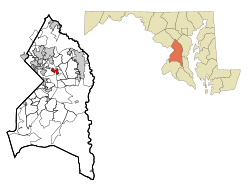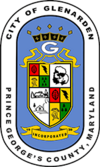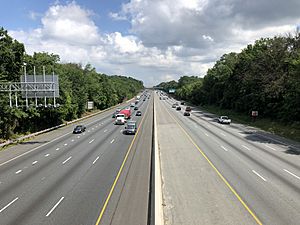Glenarden, Maryland facts for kids
Quick facts for kids
Glenarden, Maryland
|
|||
|---|---|---|---|
|
|||
| Motto(s):
"A City On The Move"
|
|||

Location of Glenarden, Maryland
|
|||
| Country | |||
| State | |||
| County | |||
| Founded | 1919 | ||
| Incorporated | March 30, 1939 | ||
| Area | |||
| • Total | 1.20 sq mi (3.10 km2) | ||
| • Land | 1.20 sq mi (3.10 km2) | ||
| • Water | 0.00 sq mi (0.00 km2) | ||
| Elevation | 102 ft (31 m) | ||
| Population
(2020)
|
|||
| • Total | 6,402 | ||
| • Density | 5,352.84/sq mi (2,066.60/km2) | ||
| Time zone | UTC-5 (Eastern (EST)) | ||
| • Summer (DST) | UTC-4 (EDT) | ||
| ZIP codes |
20706, 20774
|
||
| Area code(s) | 301, 240 | ||
| FIPS code | 24-32500 | ||
| GNIS feature ID | 0597453 | ||
Glenarden is a city located in Prince George's County, Maryland, in the United States. In 2020, about 6,402 people lived there.
Contents
History of Glenarden
Glenarden started in 1919. A person named W. R. Smith bought some land about 10 miles east of Washington. He created a small community where 15 people lived.
About 30 years later, the community grew. Many African-American middle-class families lived there. They formed a group called the Civic Association. This group asked the state government to make Glenarden an official town.
On March 30, 1939, Glenarden became an official town. This made it the third mostly Black town in Maryland. W. H. Swann was chosen as its first mayor.
Where is Glenarden?
Glenarden is located at 38°55′55″N 76°51′42″W / 38.93194°N 76.86167°W.
The United States Census Bureau says the city covers about 1.22 square miles (3.10 square kilometers). All of this area is land.
People in Glenarden
| Historical population | |||
|---|---|---|---|
| Census | Pop. | %± | |
| 1950 | 492 | — | |
| 1960 | 1,336 | 171.5% | |
| 1970 | 4,447 | 232.9% | |
| 1980 | 4,993 | 12.3% | |
| 1990 | 5,025 | 0.6% | |
| 2000 | 6,318 | 25.7% | |
| 2010 | 6,000 | −5.0% | |
| 2020 | 6,402 | 6.7% | |
| U.S. Decennial Census 2010 2020 |
|||
Population Changes Over Time
Glenarden's population has grown a lot since 1950. In 1950, only 492 people lived there. By 2020, the population had increased to 6,402 people.
Who Lives in Glenarden?
The 2020 census showed that most people in Glenarden are African American. About 77.37% of the population identified as Black or African American.
About 15.65% of the population was Hispanic or Latino. People from other racial backgrounds also live in Glenarden.
In 2010, the average age in Glenarden was 31.5 years old. Many young people live in the city, with about 31.2% of residents being under 18 years old.
Getting Around Glenarden
The main highway near Glenarden is Interstate 95/Interstate 495. This highway is also known as the Capital Beltway. It goes around Washington, D.C., connecting to many other towns.
Even though the highway is close, you cannot get directly into Glenarden from it. You can use Maryland Route 202 to connect to other local roads that lead into the city.
Glenarden is also close to two Washington Metro train stations:
- The New Carrollton Metro Station is to the north.
- The Landover Metro station is to the west.
Both stations are on the Orange Line of the Metro system.
The New Carrollton station will also be the end of the new Purple Line. This is a light rail system that will connect to other Metro lines. The Purple Line is expected to open in 2026.
Schools in Glenarden
The schools in Glenarden are part of the Prince George's County Public Schools system.
Here are some of the elementary schools that serve parts of the city:
- Ardmore Elementary School
- Dodge Park Elementary School
- Kingsford Elementary School
- William Paca Elementary School
- Judge Sylvania W. Woods, Sr. Elementary School
Glenarden also has Glenarden Woods Elementary School, which is a non-zoned school.
For middle school, students may attend Kenmoor or Ernest Everett Just. High school students in Glenarden go to DuVal High School or Charles H. Flowers High School.
Nearby Areas
Glenarden is next to these communities:
- Springdale (Northeast)
- Palmer Park (Southwest)
- Capitol Heights (Southwest)
- Lanham (Northwest)
See also
 In Spanish: Glenarden (Maryland) para niños
In Spanish: Glenarden (Maryland) para niños




